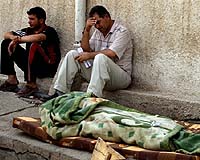| . |  |
. |
Wellington, New Zealand (UPI) Oct 9, 2009 New Zealand's aging UH-1 Iroquois helicopters have begun one of their last major military exercises before their replacement NH90s start arriving next year. Up to six Bell "Huey" Iroquois and more than 100 air force personnel from the New Zealand air force's Number 3 Squadron based out of Tekapo Military Camp started taking part in exercise Steel Talon this week, a statement from the Ministry of Defense said. The detachment commander for the exercise, Flight Lt. Ben Stephens, said Steel Talon is the squadron's major tactical flying exercise of the year, running up to Oct. 22 and will include some night flying. "For aircrew this means the opportunity to train in tactical operations, using a number of aircraft and flying as low as 50 feet, while ground crews will be practicing maintenance support from a remote location. "This training will maintain our capability to deploy overseas if requested by the government. Exercises such as Steel Talon have given us the ability to contribute to operations in East Timor, the Solomon Islands and Bougainville over the past decade." The helicopters will be fitted with Belgian-made MAG 58 7.62 mm general purpose machine guns, door mounted and firing blanks during the exercise. There will be no live firing at any time. A $475 million deal was signed in July 2007 by Defense Minister Phil Goff with Europe's NH Industries for nine NH90 helicopters to replace the Hueys. The first machine is to arrive next year with all NH90s delivered by 2011, according to the Ministry of Defense. The medium-size twin-engine NH90 is the tactical transport version with a full-glass cockpit and advanced fly-by-wire controls. Initial support will be provided by the consortium NH Industries whose joint venture partners are AgustaWestland (32 percent), Eurocopter (62.5 percent) and Stork Fokker (5.5 percent). The 10-ton NH90, which first flew in 1996, uses composite materials instead of riveted alloy plates. It also carries up to 19 rather than eight passengers as a Huey, or 12 fully equipped troops as opposed to five. It is more than a third faster, reaching 160 mph cruising speed. Maximum range is nearly 500 miles rather than 110. The Iroquois, also known as the Bell 204/205 in its civilian version, has been used by New Zealand since 1966. The air force has periodically considered major upgrades because of concerns over airframe fatigue problems, including fin spars and rotor blades and limited performance in tropical conditions such as when deployed in East Timor between 1999 and 2002. The Ministry of Defense has a project team based at Marignane, France, the Eurocopter manufacturing plant for the New Zealand machines. The team is managing ongoing acquisition and overseeing development and production. The NH90 helicopter purchase is part of New Zealand's $2.45 billion Long-term Development Plan to make sure that its military can meet minimum required capability levels. The NH90s will be deployed along with BAE Systems Pinzgauer trucks and light armored vehicles in the new 9,000t multi-role vessel HMNZS Canterbury, the country's first strategic sealift shift commissioned in June 2007. Share This Article With Planet Earth
Related Links The Military Industrial Complex at SpaceWar.com Learn about the Superpowers of the 21st Century at SpaceWar.com
 Campaigners press for arms trade deal
Campaigners press for arms trade dealLondon (AFP) Oct 7, 2009 Some 2.1 million people have died either directly or indirectly from armed violence over the last three years as talks on a global arms trade treaty have stalled, campaigners said Wednesday. More than 2,000 people have died from such violence every day since 2006, when governments agreed on the need to regulate the arms trade, said British charity Oxfam and 11 other non-governmental ... read more |
|
| The content herein, unless otherwise known to be public domain, are Copyright 1995-2009 - SpaceDaily. AFP and UPI Wire Stories are copyright Agence France-Presse and United Press International. ESA Portal Reports are copyright European Space Agency. All NASA sourced material is public domain. Additional copyrights may apply in whole or part to other bona fide parties. Advertising does not imply endorsement,agreement or approval of any opinions, statements or information provided by SpaceDaily on any Web page published or hosted by SpaceDaily. Privacy Statement |